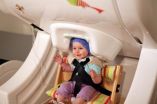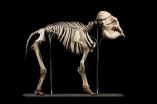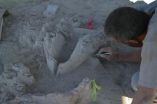(Press-News.org) Infants can tell the difference between sounds of all languages until about 8 months of age when their brains start to focus only on the sounds they hear around them. It's been unclear how this transition occurs, but social interactions and caregivers' use of exaggerated "parentese" style of speech seem to help.
University of Washington research in 7- and 11-month-old infants shows that speech sounds stimulate areas of the brain that coordinate and plan motor movements for speech.
The study, published July 14 in the Proceedings of the National Academy of Sciences, suggests that baby brains start laying down the groundwork of how to form words long before they actually begin to speak, and this may affect the developmental transition.
"Most babies babble by 7 months, but don't utter their first words until after their first birthdays," said lead author Patricia Kuhl, who is the co-director of the UW's Institute for Learning and Brain Sciences. "Finding activation in motor areas of the brain when infants are simply listening is significant, because it means the baby brain is engaged in trying to talk back right from the start and suggests that 7-month-olds' brains are already trying to figure out how to make the right movements that will produce words."
Kuhl and her research team believe this practice at motor planning contributes to the transition when infants become more sensitive to their native language.
The results emphasize the importance of talking to kids during social interactions even if they aren't talking back yet.
"Hearing us talk exercises the action areas of infants' brains, going beyond what we thought happens when we talk to them," Kuhl said. "Infants' brains are preparing them to act on the world by practicing how to speak before they actually say a word."
In the experiment, infants sat in a brain scanner that measures brain activation through a noninvasive technique called magnetoencephalography. Nicknamed MEG, the brain scanner resembles an egg-shaped vintage hair dryer and is completely safe for infants. The Institute for Learning and Brain Sciences was the first in the world to use such a tool to study babies while they engaged in a task.
Here's a video of one the babies in the experiment: https://www.youtube.com/watch?v=aFJNTaPvXpk&feature=youtu.be
The babies, 57 7- and 11- or 12-month-olds, each listened to a series of native and foreign language syllables such as "da" and "ta" as researchers recorded brain responses. They listened to sounds from English and Spanish.
The researchers observed brain activity in an auditory area of the brain called the superior temporal gyrus, as well as in Broca's area and the cerebellum, cortical regions responsible for planning the motor movements required for producing speech.
This pattern of brain activation occurred for sounds in the 7-month-olds' native language (English) as well as in a non-native language (Spanish), showing that at this early age infants are responding to all speech sounds, whether or not they have heard the sounds before.
In the older infants, brain activation was different. By 11-12 months, infants' brains increase motor activation to the non-native speech sounds relative to native speech, which the researchers interpret as showing that it takes more effort for the baby brain to predict which movements create non-native speech. This reflects an effect of experience between 7 and 11 months, and suggests that activation in motor brain areas is contributing to the transition in early speech perception.
The study has social implications, suggesting that the slow and exaggerated parentese speech – "Hiiiii! How are youuuuu?" – may actually prompt infants to try to synthesize utterances themselves and imitate what they heard, uttering something like "Ahhh bah bah baaah."
"Parentese is very exaggerated, and when infants hear it, their brains may find it easier to model the motor movements necessary to speak," Kuhl said.
INFORMATION:
Co-authors Rey Ramirez, Alexis Bosseler, Jo-Fu Lotus Lin and Toshiaki Imada are all with UW's Institute for Learning & Brain Sciences.
The National Science Foundation Science of Learning Program grant to the UW's LIFE Center funded the study.
For more information, contact Kuhl at 206-685-1921 or pkkuhl@uw.edu.
Months before their first words, babies' brains rehearse speech mechanics
2014-07-14
ELSE PRESS RELEASES FROM THIS DATE:
Moderate alcohol use associated with increased risk for atrial fibrillation
2014-07-14
Even in moderation, consumption of wine and hard liquor may be a risk factor for atrial fibrillation, an abnormally fast heartbeat that can lead to stroke, heart failure and dementia, according to new research published today in the Journal of the American College of Cardiology. The research did not identify a similar risk for moderate consumption of beer.
Researchers in Sweden studied 79,016 adults, ages 45 to 83, who completed an extensive questionnaire about food and alcohol consumption in 1997. The researchers followed the participants for up to 12 years through ...
Genome-wide analysis reveals genetic similarities among friends
2014-07-14
If you consider your friends family, you may be on to something. A study from the University of California, San Diego, and Yale University finds that friends who are not biologically related still resemble each other genetically.
Published in the Proceedings of the National Academy of Sciences, the study is coauthored by James Fowler, professor of medical genetics and political science at UC San Diego, and Nicholas Christakis, professor of sociology, evolutionary biology, and medicine at Yale.
"Looking across the whole genome," Fowler said, "we find that, on average, ...
Running for life: How speed restricts evolutionary change of the vertebral column
2014-07-14
One of the riddles of mammal evolution explained: the strong conservation of the number of trunk vertebrae. Researchers of the Naturalis Biodiversity Center and the University of Utah show that this conservation is probably due to the essential role of speed and agility in survival of fast running mammals. They measured variation in vertebrae of 774 individual mammal skeletons of both fast and slow running species. The researchers found that a combination of developmental and biomechanical problems prevents evolutionary change in the number of trunk vertebrae in fast ...
Meet the gomphothere: UA archaeologist involved in discovery of bones of elephant ancestor
2014-07-14
An animal once believed to have disappeared from North America before humans ever arrived there might actually have roamed the continent longer than previously thought – and it was likely on the list of prey for some of continent's earliest humans, researchers from the University of Arizona and elsewhere have found.
Archaeologists have discovered artifacts of the prehistoric Clovis culture mingled with the bones of two gomphotheres – an ancient ancestor of the elephant – at an archaeological site in northwestern Mexico.
The discovery suggests that the Clovis – the ...
Acute glaucoma discovered to be an inflammatory disease
2014-07-14
Researchers at the University of California, San Diego School of Medicine and Sun Yat-sen University in China have shown that acute glaucoma in mice is largely an inflammatory disease and that high pressure in the eye causes vision loss by setting in motion an inflammatory response similar to that evoked by bacterial infections.
The study, published in this week's issue of the Proceedings of the National Academy of Sciences, has immediate clinical relevance in treating the tens of millions of people worldwide from what is known as acute closed-angle glaucoma.
"Our research ...
CRISPR system can promote antibiotic resistance
2014-07-14
CRISPR, a system of genes that bacteria use to fend off viruses, is involved in promoting antibiotic resistance in Francisella novicida, a close relative of the bacterium that causes tularemia. The finding contrasts with previous observations in other bacteria that the CRISPR system hinders the spread of antibiotic resistance genes.
The results are scheduled for publication in PNAS Early Edition.
The CRISPR system has attracted considerable attention for its potential uses in genetic engineering and biotechnology, but its roles in bacterial gene regulation are still ...
Older adults nearly twice as likely to have memories affected by distractions
2014-07-14
Older people are nearly twice as likely as their younger counterparts to have their memory and cognitive processes impaired by environmental distractions (such as irrelevant speech or written words presented along with target stimuli), according to a new study from psychologists at Rice University and Johns Hopkins University School of Medicine. Whereas other studies had found that older adults are distracted by memories of prior similar events, this was the first study to convincingly demonstrate across several tasks an impairment from environmental distractions.
"Cognitive ...
EARTH Magazine: Parasites spread across the Arctic under the 'new normal'
2014-07-14
Alexandria, Va. — The last several decades have seen Arctic sea-ice minimums drop by more than half in area and more than three-quarters in volume. With current models predicting further reductions, scientists are calling it the "new normal" and are trying to grasp its implications — one of which is the occurrence of pathogens never before seen in the Arctic.
Ice is a major eco-barrier for pathogens, but with Arctic ice diminishing rapidly amid the changing climate, pathogens have an opportunity to move into new areas and spread disease as mammals increase their ranges ...
Capturing cancer: A powerful new technique for early diagnosis
2014-07-14
Despite impressive medical strides, cancer remains a leading killer and overwhelming burden to healthcare systems, causing well over a half million fatalities per year with a projected cost of $174 billion by 2020, according to the National Cancer Institute. Reducing the human and economic toll will require diagnosis and intervention at early stages of illness, when the best prognosis for a cure exists.
In recent years, aggressive research and substantial financial investments have been directed at discovering pre-symptomatic indicators of cancer, known as biomarkers. ...
Labs characterize carbon for batteries
2014-07-14
Lithium-ion batteries could benefit from a theoretical model created at Rice University and Lawrence Livermore National Laboratory that predicts how carbon components will perform.
The model is based on intrinsic characteristics of materials used as battery electrodes. These include limitations on quantum capacitance (the ability of the material to absorb charge) and the material's absolute Fermi level, which determines how many lithium ions may bond to the electrodes.
Subtle changes in the structure, chemistry and shape of an electrode will alter how strongly lithium ...



